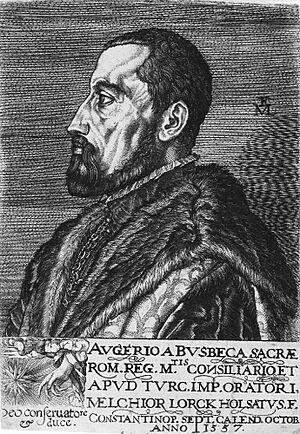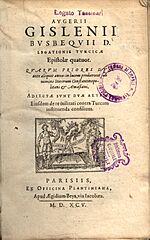Ogier Ghiselin de Busbecq facts for kids
Ogier Ghiselin de Busbecq (born 1522 in Comines – died 29 October 1592 in Saint-Germain-sous-Cailly) was a famous writer, plant expert, and diplomat from the 1500s. He was from Flanders, which is now part of Belgium and France.
Busbecq worked for three different Austrian rulers. He was an ambassador to the powerful Ottoman Empire in Constantinople (today's Istanbul, Turkey). In 1581, he published a book about his time there called Turkish Letters. This book is still very important for understanding the 16th century. He is also known for bringing tulips to Western Europe.
Contents
Early Life and Education
Ogier Ghiselin de Busbecq grew up at Busbecq Castle in what is now France. He studied in Wervik and Comines. These places were part of West Flanders at the time.
He was very smart and went on to study at the Old University of Leuven in Belgium in 1536. After that, he studied at several well-known universities in northern Italy. One of his teachers was Giovanni Battista Egnazio in Venice.
Like his father and grandfather, Busbecq chose a career in public service. He started working for Ferdinand I, who later became the Holy Roman Emperor, around 1552. In 1554, he was sent to England. He attended the wedding of Queen Mary Tudor to Philip II of Spain in Winchester.
Time in the Ottoman Empire
In 1554 and again in 1556, Ferdinand sent Busbecq as an ambassador to the Ottoman Empire. This empire was ruled by Suleiman the Magnificent. Busbecq's main job in Constantinople was to negotiate a border treaty. This treaty was about a disputed area called Transylvania.
He didn't have much success at first. But he eventually reached an agreement with the Sultan's new chief minister, Semiz Ali Pasha.
The Turkish Letters
During his time in Constantinople, Busbecq wrote his most famous work. It was called the Turkish Letters. These letters were personal notes to his friend, Nicholas Michault, who was also a diplomat. The letters are some of the world's first travel literature.
These letters describe his adventures in Ottoman politics. They are still a very important source for students learning about the Ottoman court in the 1500s. He also wrote in great detail about the plants and animals he saw in Turkey. His letters even contain the only known list of words from Crimean Gothic. This was a German language spoken in some parts of Crimea back then.
Discoveries and Collections
Busbecq was a keen collector. He gathered valuable old writings, rare coins, and interesting objects. One of his most famous discoveries was an almost complete copy of the Res Gestae Divi Augusti. This was an ancient Roman text about the life of Emperor Augustus. He found it in Ancyra (modern-day Ankara). He published parts of it in his Turkish Letters.
He also found a 6th-century copy of Dioscorides' De Materia Medica. This book was a collection of information about medicinal herbs. The emperor bought it after Busbecq suggested it. This old book is now known as the Vienna Dioscorides.
Busbecq loved plants. He sent Turkish tulip bulbs to his friend Charles de l'Écluse. His friend helped the tulips grow in the Low Countries (modern-day Netherlands and Belgium). Busbecq called them "tulip" because he thought the Turkish word for turban (tulipant) was the name of the flower. Turbans were often decorated with these flowers. Busbecq is also credited with bringing the lilac flower and the Angora goat to northern Europe.
Life After Turkey
Busbecq returned from Turkey in 1562. He became an advisor at the court of Emperor Ferdinand in Vienna. He also tutored Ferdinand's grandchildren.
Later, Busbecq became the guardian of Elisabeth of Austria. She was the daughter of Emperor Maximilian II and the widow of French king Charles IX. Busbecq continued to serve the Austrian monarchy. He watched the events of the French Wars of Religion for Rudolf II.
In 1592, near the end of his life, he decided to leave his home near Paris. He wanted to return to his home in West Flanders. However, he was attacked and robbed by a group of people near Rouen. He died a few days later. His body is buried in a chapel near where he died. His heart was sent to his family's tomb in Bousbecque.
See also
- Manuscripts Busbecq brought from Constantinople: Minuscule 218, Minuscule 222, Minuscule 421, Minuscule 434, Minuscule 425, Minuscule 719, Minuscule 722
- List of Austrian ambassadors to Turkey




